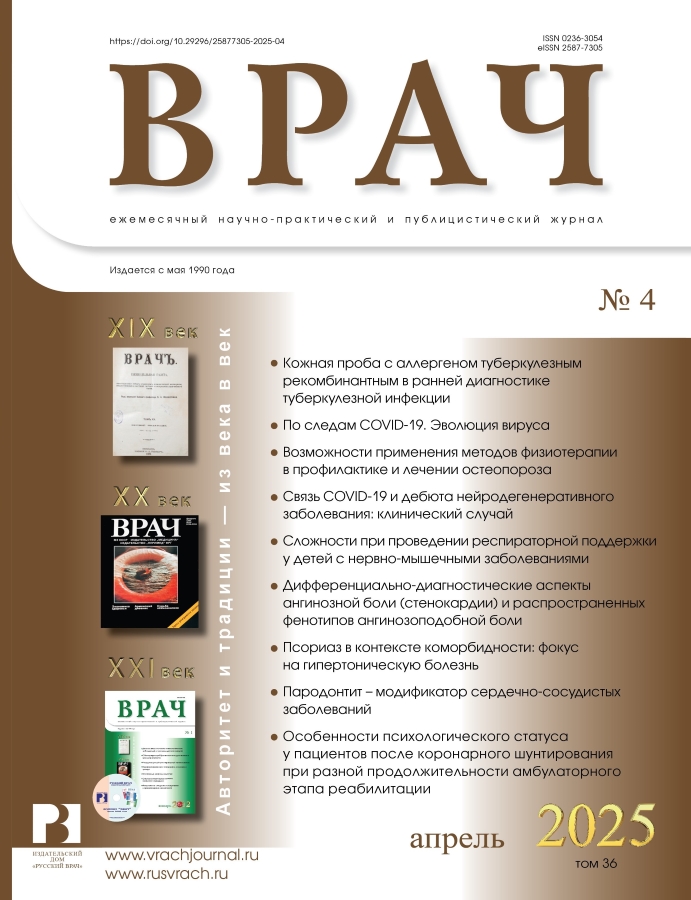Psoriasis in the context of comorbidity: focus for hypertension
- Authors: Muminova M.S.1, Zhukova O.V.1,2, Plieva K.T.2, Korsunskaya I.M.3
-
Affiliations:
- Peoples' Friendship University of Russia
- Moscow Scientific and Practical Center for Dermatovenereology and Cosmetology of the Moscow Department of Health
- Center for Theoretical Problems of Physico-Chemical Pharmacology of the Russian Academy of Sciences
- Issue: Vol 36, No 4 (2025)
- Pages: 41-44
- Section: From Practice
- URL: https://journals.eco-vector.com/0236-3054/article/view/679101
- DOI: https://doi.org/10.29296/25877305-2025-04-08
- ID: 679101
Cite item
Abstract
Purpose. Compare the frequency of occurrence of comorbid pathologies in patients with psoriasis and concomitant hypertension and patients with psoriasis without hypertension, evaluate the severity of psoriasis in patients with concomitant hypertension.
Material and methods. The study was attended by 120 patients with psoriasis, divided into 2 groups: 1st (n = 60) – patients with psoriasis and hypertension; 2nd (n = 60) – patients with psoriasis without hypertension. The study included the analysis of the stories of the disease, the collection of complaints, the anamnesis of the disease, the anamnesis of life, the physical examination, the measurement of blood pressure, the calculation of the prevalence index and the severity of psoriasis (PASI).
Results. In patients with psoriasis and concomitant hypertension, the course of the underlying disease took place in a more severe form with a high PASI index. The predominance of exudative forms of the disease, the progressive stage with damage to the scalp, trunk, upper and lower extremities, was noted, and in 43.3% of patients and involving the skin of the face in the pathological process. The number of related diseases and the percentage of patients with polymorbid pathology in a group of patients with psoriasis and hypertension were significantly greater. In this group of patients, a longer stay in the hospital was also noted.
Conclusion. In patients with psoriasis, the concomitant hypertension contributes to a more severe course of the skin process, increase the comorbid load, increase polymorbidity and lengthen the temporary disability, thereby worsening the quality of life of patients.
Keywords
Full Text
About the authors
M. S. Muminova
Peoples' Friendship University of Russia
Author for correspondence.
Email: marykor@bk.ru
ORCID iD: 0000-0002-8620-6266
Russian Federation, Moscow
O. V. Zhukova
Peoples' Friendship University of Russia; Moscow Scientific and Practical Center for Dermatovenereology and Cosmetology of the Moscow Department of Health
Email: marykor@bk.ru
ORCID iD: 0000-0001-5723-6573
SPIN-code: 8584-7564
MD, Professor
Russian Federation, Moscow; MoscowK. T. Plieva
Moscow Scientific and Practical Center for Dermatovenereology and Cosmetology of the Moscow Department of Health
Email: marykor@bk.ru
ORCID iD: 0000-0001-9351-1034
SPIN-code: 4498-8034
Russian Federation, Moscow
I. M. Korsunskaya
Center for Theoretical Problems of Physico-Chemical Pharmacology of the Russian Academy of Sciences
Email: marykor@bk.ru
ORCID iD: 0000-0002-6583-0318
SPIN-code: 3335-2019
MD, Professor
Russian Federation, MoscowReferences
- Branisteanu D.E., Nicolescu A.C., Branisteanu D.C. et al. Cardiovascular comorbidities in psoriasis (Review). Exp Ther Med. 2022; 23 (2): 152. doi: 10.3892/etm.2021.11075
- Armstrong A.W., Read C. Pathophysiology, clinical presentation, and treatment of psoriasis: a review. JAMA. 2020; 323 (19): 1945–60. doi: 10.1001/jama.2020.4006
- Orlando G., Molon B., Viola A. et al. Psoriasis and cardiovascular diseases: an immune-mediated cross talk? Front Immunol. 2022; 13: 868277. doi: 10.3389/fimmu.2022.868277
- Gisondi P., Bellinato F., Girolomoni G. et al. Pathogenesis of chronic plaque psoriasis and its intersection with cardio-metabolic comorbidities. Front Pharmacol. 2020; 11: 117. doi: 10.3389/fphar.2020.00117
- Nicholas M.N., Gooderham M. Psoriasis, depression, and suicidality. Skin Therapy Lett. 2017; 22 (3): 1–4.
- Daugaard C., Iversen L., Hjuler K.F. Comorbidity in adult psoriasis: considerations for the clinician. Psoriasis Targets Ther. 2021; 11: 41–52. doi: 10.2147/PTT.S328572
- Cottone M., Sapienza C., Macaluso F.S. et al. Psoriasis and inflammatory bowel disease. Dig Dis. 2019; 37 (6): 451–7. doi: 10.1159/000500116
- Whitlock S.M., Enos C.W., Armstrong A.W. et al. Management of psoriasis in patients with inflammatory bowel disease: from the Medical Board of the National Psoriasis Foundation. J Am Acad Dermatol. 2018; 78 (2): 383–94. doi: 10.1016/j.jaad.2017.06.043
- Fu Y., Lee C.H., Chi C.C. Association of psoriasis with inflammatory bowel disease: a systematic review and meta-analysis. JAMA Dermatol. 2018; 154 (12): 1417–23. doi: 10.1001/jamadermatol.2018.3631
- De Brandt E., Hillary T. Comorbid Psoriasis and Metabolic Syndrome: Clinical Implications and Optimal Management. Psoriasis (Auckl). 2022; 12: 113–26. doi: 10.2147/PTT.S293107
- Cordingley L., Nelson P.A., Davies L. et al. Identifying and managing psoriasis-associated comorbidities: the IMPACT research programme. Southampton (UK): NIHR Journals Library; 2022. doi: 10.3310/LVUQ5853
- Liu L., Cui S., Liu M. et al. Psoriasis increased the risk of adverse cardiovascular outcomes: a new systematic review and meta-analysis of cohort study. Front Cardiovasc Med. 2022; 9: 829709. doi: 10.3389/fcvm.2022.829709
- Hu S.C., Lan C.E. Psoriasis and cardiovascular comorbidities: Focusing on severe vascular events, cardiovascular risk factors and implications for treatment. Int J Mol Sci. 2017; 18 (10): 2211. doi: 10.3390/ijms18102211
- Masson W., Lobo M., Molinero G. Psoriasis and cardiovascular risk: a comprehensive review. Adv Ther. 2020; 37 (5): 2017–33. doi: 10.1007/s12325-020-01350-6
- Tinggaard A.B., Hjuler K.F., Andersen I.T. et al. Prevalence and severity of coronary artery disease linked to prognosis in psoriasis and psoriatic arthritis patients: a multi-centre cohort study. J Intern Med. 2021; 290: 693–703. doi: 10.1111/joim.13311
- Jindal S., Jindal N. Psoriasis and cardiovascular diseases: A literature review to determine the causal relationship. Cureus. 2018; 10 (2): e2195. doi: 10.7759/cureus.2195
Supplementary files







